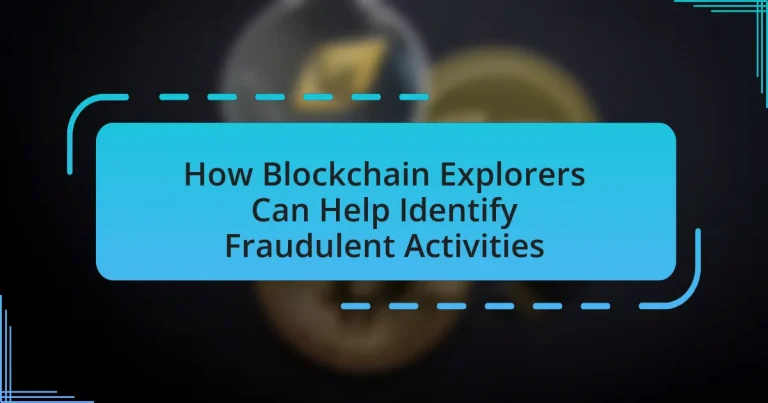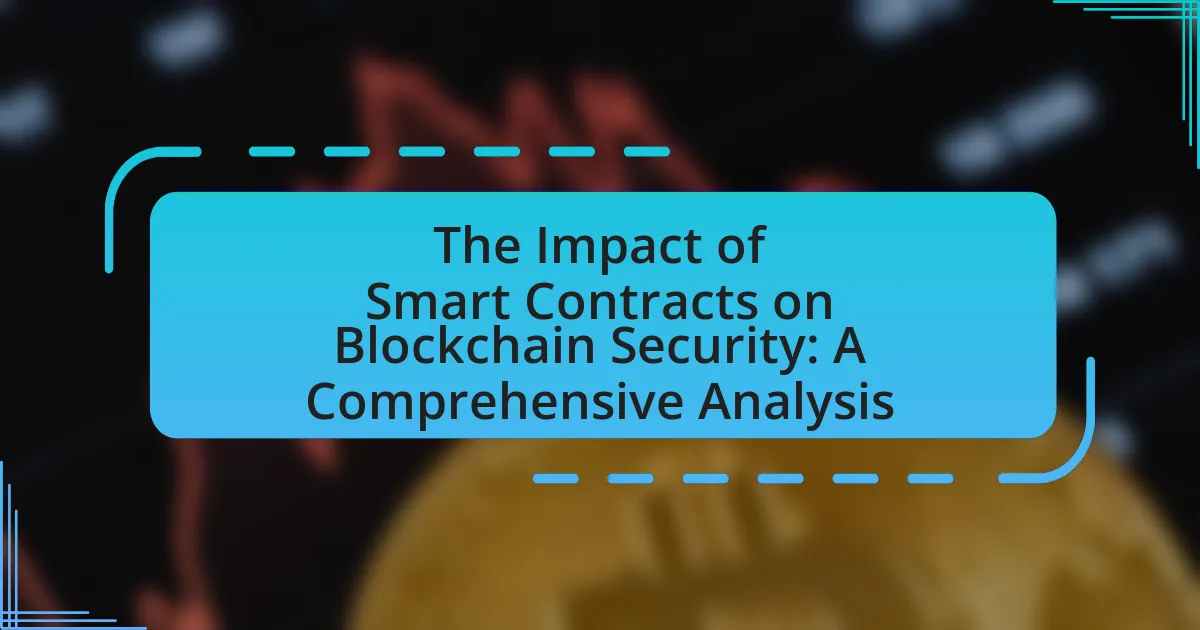Blockchain explorers are online tools that enable users to view and analyze blockchain transactions, playing a vital role in fraud detection through enhanced transparency and traceability. This article explores how these explorers function, the technologies they utilize, and their effectiveness in identifying various fraudulent activities such as money laundering and Ponzi schemes. It also discusses the challenges faced by blockchain explorers, including privacy concerns and regulatory impacts, while highlighting best practices for organizations to implement these tools effectively in their fraud detection strategies. Additionally, the article emphasizes the importance of training users to maximize the capabilities of blockchain explorers in combating fraud.
What are Blockchain Explorers and Their Role in Fraud Detection?
Blockchain explorers are online tools that allow users to view and analyze blockchain transactions and data. They play a crucial role in fraud detection by providing transparency and traceability of transactions, enabling users to track the flow of funds and identify suspicious activities. For instance, blockchain explorers can reveal patterns of behavior, such as unusual transaction volumes or rapid transfers between addresses, which may indicate fraudulent schemes. The ability to access detailed transaction histories and wallet addresses empowers investigators and users to verify the legitimacy of transactions, thereby enhancing security and trust in blockchain networks.
How do Blockchain Explorers function in tracking transactions?
Blockchain explorers function by providing a user-friendly interface to access and analyze blockchain data, enabling the tracking of transactions. They allow users to input transaction IDs, wallet addresses, or block numbers to retrieve detailed information about specific transactions, including timestamps, amounts, and the parties involved. This functionality is supported by the transparent and immutable nature of blockchain technology, where all transactions are recorded on a public ledger. For instance, Bitcoin’s blockchain explorer can show the entire transaction history associated with a wallet address, making it easier to trace the flow of funds and identify patterns that may indicate fraudulent activities.
What technologies do Blockchain Explorers utilize for tracking?
Blockchain explorers utilize technologies such as APIs, data indexing, and blockchain nodes for tracking transactions. APIs allow explorers to retrieve and display transaction data from various blockchains, while data indexing organizes this information for efficient querying. Blockchain nodes maintain a copy of the entire blockchain, enabling real-time access to transaction history and network activity. These technologies collectively enhance the ability to monitor and analyze blockchain transactions, aiding in the identification of fraudulent activities.
How do Blockchain Explorers ensure data integrity?
Blockchain explorers ensure data integrity by providing transparent access to the blockchain’s immutable ledger. They allow users to verify transactions and blocks through cryptographic hashes, which are unique identifiers that link each block to its predecessor, creating a secure chain. This structure prevents unauthorized alterations, as any change in a block would require recalculating the hashes of all subsequent blocks, a computationally infeasible task. Additionally, blockchain explorers often display transaction confirmations, which indicate the number of times a transaction has been validated by the network, further reinforcing the reliability of the data presented.
Why are Blockchain Explorers essential for identifying fraudulent activities?
Blockchain explorers are essential for identifying fraudulent activities because they provide transparent access to transaction data on the blockchain. This transparency allows users to trace the flow of funds, verify transaction histories, and identify suspicious patterns or anomalies. For instance, blockchain explorers can reveal multiple transactions from a single address, which may indicate money laundering or other illicit activities. Additionally, the immutable nature of blockchain records ensures that once a transaction is recorded, it cannot be altered, making it easier to hold parties accountable and investigate fraudulent behavior.
What types of fraudulent activities can be detected using Blockchain Explorers?
Blockchain Explorers can detect various types of fraudulent activities, including money laundering, Ponzi schemes, and phishing scams. These explorers provide transparency by allowing users to trace transactions on the blockchain, making it easier to identify suspicious patterns or large, unexplained transfers that may indicate money laundering. For instance, the ability to analyze transaction histories can reveal connections between wallets involved in Ponzi schemes, where funds are often funneled through multiple addresses to obscure their origin. Additionally, phishing scams can be tracked by monitoring unusual transaction behaviors or sudden spikes in activity linked to specific addresses. This capability to analyze and visualize blockchain data is crucial for law enforcement and regulatory bodies in combating fraud effectively.
How do Blockchain Explorers enhance transparency in transactions?
Blockchain explorers enhance transparency in transactions by providing real-time access to transaction data recorded on the blockchain. These tools allow users to view transaction histories, including sender and receiver addresses, transaction amounts, and timestamps, which are publicly available and immutable. For instance, Bitcoin blockchain explorers like Blockchair and Blockchain.com enable users to trace the flow of funds, making it easier to verify the legitimacy of transactions. This transparency helps deter fraudulent activities, as any suspicious transactions can be easily identified and investigated by users and authorities alike.
What Techniques Do Blockchain Explorers Use to Identify Fraud?
Blockchain explorers use techniques such as transaction analysis, address clustering, and pattern recognition to identify fraud. Transaction analysis involves examining the flow of funds between addresses to detect suspicious activities, while address clustering groups related addresses to reveal potential fraudulent networks. Pattern recognition identifies unusual transaction patterns that deviate from typical behavior, indicating possible fraud. These methods are supported by the transparent and immutable nature of blockchain technology, which allows for comprehensive tracking and verification of transactions.
How do Blockchain Explorers analyze transaction patterns?
Blockchain explorers analyze transaction patterns by aggregating and visualizing data from blockchain networks. They track transaction histories, including timestamps, amounts, and addresses involved, allowing users to identify trends and anomalies. For instance, explorers can highlight unusual spikes in transaction volume or identify addresses that frequently interact with known fraudulent entities, which can indicate potential illicit activities. This analytical capability is supported by the transparent nature of blockchain technology, where all transactions are recorded on a public ledger, enabling real-time monitoring and historical analysis.
What algorithms are employed in pattern recognition?
Algorithms employed in pattern recognition include neural networks, support vector machines, decision trees, k-nearest neighbors, and hidden Markov models. These algorithms are utilized to identify patterns and classify data based on features extracted from input data. For instance, neural networks, particularly deep learning models, have shown significant success in image and speech recognition tasks, achieving high accuracy rates in various applications. Support vector machines are effective in high-dimensional spaces, making them suitable for text classification. Decision trees provide interpretable models for decision-making processes, while k-nearest neighbors is a simple yet powerful algorithm for classification based on proximity. Hidden Markov models are widely used in temporal pattern recognition, such as speech and handwriting recognition.
How can anomalies in transaction patterns indicate fraud?
Anomalies in transaction patterns can indicate fraud by revealing unusual behaviors that deviate from established norms. For instance, a sudden spike in transaction frequency or amounts, especially in accounts that typically exhibit low activity, can signal potential fraudulent activity. Research shows that 30% of fraud cases are detected through pattern recognition techniques, highlighting the effectiveness of monitoring transaction anomalies. Additionally, transactions occurring at odd hours or involving multiple rapid transfers to different accounts can further suggest illicit behavior, as these patterns often do not align with legitimate user activity.
What role does data visualization play in fraud detection?
Data visualization plays a crucial role in fraud detection by enabling analysts to identify patterns, anomalies, and trends in large datasets quickly and effectively. By transforming complex data into visual formats such as graphs, charts, and heat maps, data visualization allows for the immediate recognition of suspicious activities that may indicate fraudulent behavior. For instance, a study by the Association of Certified Fraud Examiners found that visual analytics can reduce the time taken to detect fraud by up to 50%, highlighting its effectiveness in enhancing investigative processes.
How do visual tools help in understanding transaction flows?
Visual tools enhance the understanding of transaction flows by providing clear graphical representations of complex data. These tools, such as flowcharts and network diagrams, allow users to visualize the sequence and relationships between transactions, making it easier to identify patterns and anomalies. For instance, blockchain explorers display transaction histories in a user-friendly format, enabling users to trace the movement of assets across the network. This visual clarity aids in detecting irregularities that may indicate fraudulent activities, as users can quickly spot unusual transaction volumes or unexpected connections between entities.
What are the benefits of using graphs and charts in fraud analysis?
Graphs and charts enhance fraud analysis by providing visual representations of complex data, making patterns and anomalies easier to identify. These visual tools allow analysts to quickly discern trends, relationships, and outliers in large datasets, which is crucial for detecting fraudulent activities. For instance, a study by the Association of Certified Fraud Examiners found that visual data representation can increase the speed of fraud detection by up to 30%, as it simplifies the interpretation of intricate information. This efficiency is vital in the fast-paced environment of fraud detection, where timely insights can prevent further financial loss.
What Challenges Do Blockchain Explorers Face in Fraud Detection?
Blockchain explorers face significant challenges in fraud detection primarily due to the pseudonymous nature of blockchain transactions. This anonymity complicates the identification of the parties involved in fraudulent activities, making it difficult to trace illicit transactions back to their origin. Additionally, the sheer volume of transactions on popular blockchains can overwhelm explorers, hindering their ability to analyze data effectively.
Moreover, the evolving tactics of fraudsters, such as using mixing services to obfuscate transaction trails, further complicate detection efforts. According to a report by Chainalysis, over $10 billion was laundered through cryptocurrency mixing services in 2021, illustrating the scale of the challenge. These factors collectively impede the effectiveness of blockchain explorers in identifying and mitigating fraudulent activities.
How do privacy concerns impact the effectiveness of Blockchain Explorers?
Privacy concerns significantly hinder the effectiveness of Blockchain Explorers by limiting the transparency and traceability of transactions. When users prioritize anonymity, it becomes challenging for Blockchain Explorers to track and analyze transaction patterns, which are essential for identifying fraudulent activities. For instance, the rise of privacy-focused cryptocurrencies like Monero and Zcash employs advanced cryptographic techniques that obscure transaction details, making it difficult for Blockchain Explorers to provide accurate insights. Consequently, the inability to access complete transaction data reduces the overall utility of these tools in detecting and preventing fraud within the blockchain ecosystem.
What measures can be taken to balance privacy and fraud detection?
To balance privacy and fraud detection, organizations can implement privacy-preserving technologies such as zero-knowledge proofs and differential privacy. These technologies allow for the verification of transactions or identities without revealing sensitive information. For instance, zero-knowledge proofs enable one party to prove to another that a statement is true without disclosing any details about the statement itself. This method has been effectively utilized in blockchain systems to maintain user anonymity while still allowing for fraud detection. Additionally, employing robust data anonymization techniques can help protect user identities while still enabling the analysis of transaction patterns for fraudulent activities.
How do regulations affect the operation of Blockchain Explorers?
Regulations significantly impact the operation of Blockchain Explorers by imposing compliance requirements that affect data access and reporting practices. These regulations, such as the Financial Action Task Force (FATF) guidelines, mandate that Blockchain Explorers implement Know Your Customer (KYC) and Anti-Money Laundering (AML) measures, which can limit the types of data they can provide and how they can operate. For instance, in jurisdictions with stringent regulations, Blockchain Explorers may need to restrict access to certain transaction data to comply with privacy laws, thereby affecting their ability to identify fraudulent activities effectively.
What limitations exist in the current technology of Blockchain Explorers?
Current technology of Blockchain Explorers has several limitations, including scalability issues, data interpretation challenges, and privacy concerns. Scalability issues arise as the volume of transactions increases, making it difficult for explorers to process and display data efficiently. Data interpretation challenges occur because the raw blockchain data can be complex and difficult for users to analyze without advanced knowledge, leading to potential misinterpretations. Privacy concerns stem from the transparent nature of blockchain, which can expose user transaction histories, raising issues regarding anonymity and security. These limitations hinder the effectiveness of Blockchain Explorers in identifying fraudulent activities.
How can these limitations hinder fraud detection efforts?
Limitations in blockchain explorers can significantly hinder fraud detection efforts by restricting access to comprehensive transaction data. When blockchain explorers lack real-time data updates or have incomplete transaction histories, it becomes challenging for analysts to identify suspicious patterns or anomalies effectively. For instance, if a blockchain explorer does not capture all transactions related to a specific wallet, it may miss critical evidence of fraudulent activity, leading to false conclusions. Additionally, limitations in user interface design can impede the ability to visualize complex transaction flows, further complicating the detection of fraud. These factors collectively reduce the overall efficacy of fraud detection mechanisms, making it easier for fraudulent activities to go unnoticed.
What advancements are needed to improve Blockchain Explorer capabilities?
To improve Blockchain Explorer capabilities, advancements in data visualization, real-time analytics, and enhanced search functionalities are essential. Data visualization tools can help users better interpret complex blockchain data, while real-time analytics can provide immediate insights into transaction patterns, aiding in the identification of fraudulent activities. Enhanced search functionalities, including advanced filtering options and machine learning algorithms, can facilitate more efficient tracking of suspicious transactions. These improvements are crucial as they enable users to quickly identify anomalies and potential fraud, thereby increasing the overall effectiveness of Blockchain Explorers in monitoring blockchain networks.
What Best Practices Can Enhance the Use of Blockchain Explorers for Fraud Detection?
Utilizing blockchain explorers effectively for fraud detection can be enhanced by implementing several best practices. First, regularly monitoring transaction patterns allows for the identification of anomalies that may indicate fraudulent activities. For instance, a sudden spike in transactions from a specific wallet can signal potential fraud. Second, employing advanced filtering tools within blockchain explorers can help isolate suspicious transactions based on criteria such as transaction size, frequency, and associated addresses. This targeted approach increases the likelihood of detecting illicit activities. Third, integrating machine learning algorithms with blockchain explorers can automate the detection process by learning from historical data and identifying patterns indicative of fraud. Research has shown that machine learning models can improve detection rates significantly, with some studies reporting up to a 90% accuracy in identifying fraudulent transactions. Lastly, collaborating with law enforcement and regulatory bodies can enhance the effectiveness of blockchain explorers by sharing insights and data, leading to more comprehensive fraud detection strategies.
How can organizations effectively implement Blockchain Explorers in their fraud detection strategies?
Organizations can effectively implement Blockchain Explorers in their fraud detection strategies by integrating these tools to analyze transaction patterns and identify anomalies. Blockchain Explorers provide real-time visibility into blockchain transactions, allowing organizations to track the flow of funds and detect suspicious activities such as unusual transaction volumes or patterns that deviate from established norms.
For instance, by utilizing the transaction history and metadata available through Blockchain Explorers, organizations can establish baseline behaviors for typical transactions and flag any deviations for further investigation. This method has been validated by various case studies, including a report from the Association of Certified Fraud Examiners, which highlights the effectiveness of data analytics in detecting fraud. By leveraging the transparency and immutability of blockchain technology, organizations can enhance their fraud detection capabilities significantly.
What training is necessary for users of Blockchain Explorers to maximize their effectiveness?
Users of Blockchain Explorers need training in blockchain technology fundamentals, data interpretation, and specific explorer functionalities to maximize their effectiveness. Understanding blockchain concepts such as decentralization, consensus mechanisms, and transaction validation is crucial for users to navigate and analyze blockchain data accurately. Additionally, training in data interpretation skills enables users to identify patterns and anomalies that may indicate fraudulent activities. Familiarity with the specific features of the blockchain explorer, such as transaction tracking, wallet analysis, and block verification, enhances users’ ability to conduct thorough investigations. This training equips users with the necessary skills to effectively utilize Blockchain Explorers in identifying and mitigating fraudulent activities.





